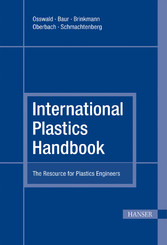Tim A. Osswald, Erwin Baur, Sigrid Brinkmann
International Plastics Handbook
CHAPTER 4
PLASTICS PROCESSES (p. 271-272)
Manufacturing of plastic parts can involve one or several of the following steps:
• Shaping operations - This involves transforming a polymer pellet, powder or resin into a final product or into a preform using extrusion or molding processes such as injection, compression molding or roto molding.
• Secondary shaping operation - Here a preform such as a parison or sheet is transformed into a final product using thermoforming or blow molding.
• Material removal - This type of operation involvesmaterial removal using machining operations, stamping, laser, drilling, etc.
• Joining operations - Here, two or more parts are assembled physically or by bonding or welding operations.
Most plastic parts are manufactured using shaping operations. Here, thematerial is deformed into its final shape at temperatures between room temperature and 350oC, using wear resistant tools, dies and molds. For example, an injection mold would allow making between 106 and 107 parts without much wear of the tool, allowing for the high cost of themolds utilized. One of themany advantages of polymer molding processes is the accuracy, sometimes with features down to the micrometer scale, with which one can shape the finished product without the need of trimming or material removal operations. For example, when making compact discs by an injection-compression molding process, it is possible to accurately produce features, that contain digital information smaller than 1µm, on a disc with a thickness of less than 1mmand a diameter of several centimeters.
The cycle time to produce such a part can be less than 3 seconds. In the past fewyears, we have seen trendswheremore complex manufacturing systems are developed that manufacture parts which use various materials and components such as co-extrusion ofmultilayer films and sheets,multi-component injection molding, sandwiched parts, or hollow products. Thermoplastics and thermoplastic elastomers are shaped and formed by heating them above glass transition or melting temperatures and then freezing them into their final shape by lowering the temperature. At that point, the crystallization, molecular or fiber orientation and residual stress distributions are an integral the finished product.
Similarly, thermosetting polymers and vulcanizing elastomers solidify by a chemical reaction that results in a cross-linked molecular structure. Here too, the filler or fiber orientation as well as the residual stresses are frozen into the finished structure after cross-linking. This chapter is intended to give an introduction to the most important polymer processes.
4.1 RAW MATERIAL PREPARATION
Raw material preparation is understood as the necessary steps taken before the polymeric material is processed into the finished product. Such steps include the addition of components or additives such as pigments, fillers, fibers, platicizers, lubricants, stabilizers, flame retardants, foaming agents, solvents, or other polymers, or the material’s transformation into a powder, paste or pellet. The most important material preparation operations are mixing, kneading, disolving, granulating or pelletizing, and drying.
4.1.1 Mixing Processes
Today, most processes involve some form of mixing. For example, an integral part of a screw extruder is a mixing zone. In fact, most twin screw extruders are primarily used as mixing devices. Similarly, the plasticating unit of an injection molding machine often has a mixing zone. This is important because the quality of the finished product in almost all polymer processes depends in part on how well the material was mixed. Both the material properties and the formability of the compound into shaped parts are highly influenced by the mixing quality. Hence, a better understanding of themixing process helps to optimize processing conditions and increase part quality.
The process of polymer blending or mixing is accomplished by distributing or dispersing aminor or secondary componentwithin amajor component serving as a matrix. The major component can be thought of as the continuous phase, and the minor components as distributed or dispersed phases in the form of droplets, filaments, or agglomerates. When creating a polymer blend, one must always keep in mind that the blend will probably be remelted in subsequent processing or shaping processes. For example, a rapidly cooled system, frozen as a homogenous mixture, can separate into phases because of coalescence when re-heated. For all practical purposes, such a blend is not processable.
© 2009-2024 ciando GmbH
 Zu Hanser-Fachbuch.de
Zu Hanser-Fachbuch.de
 Warenkorb
Warenkorb
